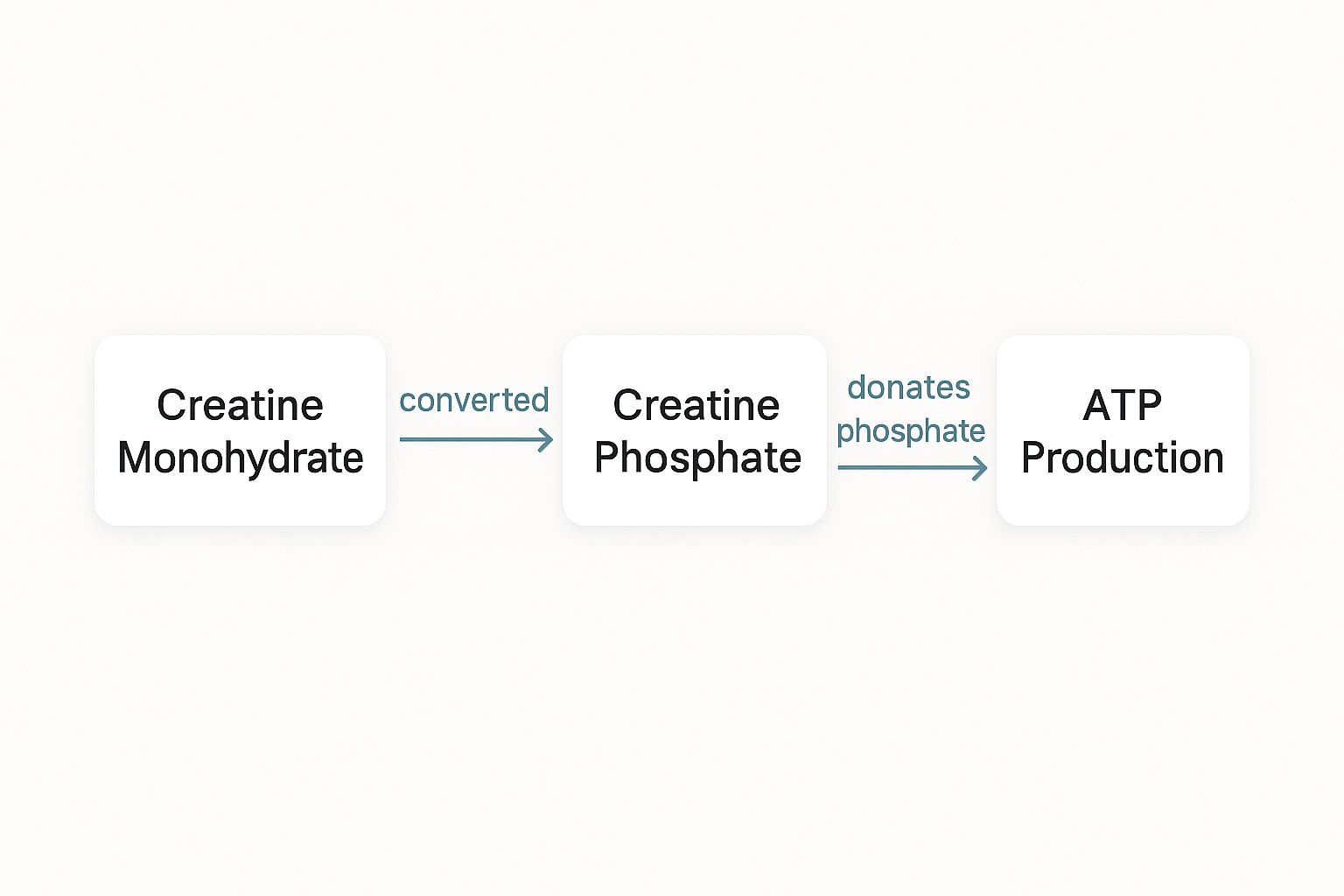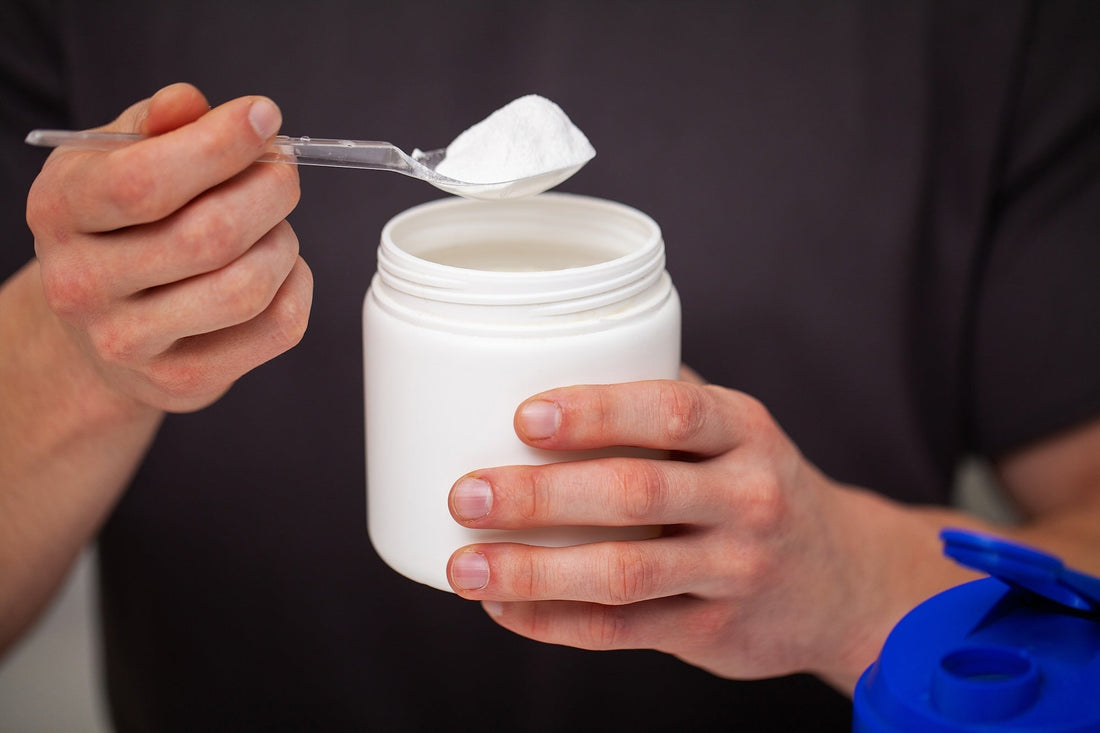Creatine monohydrate is a completely natural substance that your body already makes. Its whole job is to help your muscles churn out energy for those quick, intense bursts of effort—think lifting something heavy or sprinting for the finish line.
Imagine your muscles' main energy source, ATP, is like the battery on your phone. Creatine acts like a rapid-recharge power pack, instantly topping it up so you can keep going. This isn't some weird, lab-made chemical; it's one of the most researched, proven, and effective supplements in the fitness world.
Unpacking Creatine Monohydrate

It’s easy to get lost in the scientific jargon, but what creatine monohydrate does is actually pretty simple. It’s a compound your body builds from three amino acids: arginine, glycine, and methionine. Most of this happens in your liver and kidneys.
From there, it’s shipped off to your muscles, where over 90% of it is stored and ready for action.
You also get some creatine from food, especially protein-heavy stuff like red meat and fish. The catch? You'd have to eat an absolutely insane amount of steak every single day to get enough to really boost your performance. That’s where supplementation becomes a total game-changer for anyone serious about their training.
Here's a quick rundown of what makes creatine monohydrate tick.
Creatine Monohydrate At A Glance
| Attribute | Description |
|---|---|
| Primary Function | Rapidly replenishes ATP (the main energy currency) in muscles. |
| Key Benefit | Increases strength, power output, and muscle mass. |
| Natural Sources | Synthesized in the body; found in red meat and fish. |
| Composition | Made from the amino acids arginine, glycine, and methionine. |
| Form | The most researched and scientifically validated form of creatine. |
This table just scratches the surface, but it gives you a solid idea of why this supplement is a staple for so many.
The Cornerstone of Performance Supplements
When it comes to the different types of creatine out there, creatine monohydrate is the undisputed king. It’s the most studied and validated form available, period. Its massive popularity isn't just hype; it’s backed by decades of solid scientific proof showing it works and is safe for healthy people.
Its power to fuel high-intensity workouts has made it a must-have ingredient in many top-tier pre-workout formulas. It's why Otaku Pump includes it in every pre-workout—to make sure you can squeeze everything out of every rep and every set, pushing past your limits to unlock real gains. This is no fleeting trend; it’s a foundational tool for anyone committed to getting stronger.
Creatine is more than just a supplement; it's a key that unlocks your body’s potential for explosive power and strength, turning hard work into tangible results.
The global demand for creatine tells the whole story. The market for creatine supplements, with monohydrate leading the charge, was valued at roughly USD 639.7 million in 2025 and is on track to explode to about USD 2,171.6 million by 2035. This incredible growth is driven by a worldwide surge in fitness and the desire for better muscle endurance. You can discover more insights about this growing market trend.
Once you understand what creatine monohydrate really is—a natural, safe, and powerful energy source—it’s easy to see why it’s a trusted staple for anyone looking to level up their performance.
How Creatine Actually Fuels Your Workouts
To really get what creatine monohydrate is doing, you have to picture yourself in the middle of a tough set, fighting for those last few reps. The magic happens at a molecular level, and it all revolves around a little powerhouse molecule called ATP (adenosine triphosphate).
Think of ATP as the high-octane fuel for your muscles. It’s what powers every explosive movement, from lifting a heavy barbell to sprinting off the line. The only catch? Your muscles only keep a tiny amount on hand—just enough for a few seconds of all-out effort. Once that’s gone, your power tanks, and the set is over.
This is where creatine monohydrate comes in to save the day. It acts like a rapid-recharge system for that spent ATP, getting you back in the fight almost instantly.
The ATP-Creatine Connection
When you take creatine, your body converts it into a supercharged compound called phosphocreatine (or creatine phosphate) and stocks it up right inside your muscle cells.
As you blast through a heavy lift, you burn through your ATP, which then becomes a weaker molecule called ADP (adenosine diphosphate). But before your muscles can fail, phosphocreatine jumps in, donates its phosphate molecule back to ADP, and instantly turns it back into powerful ATP. This lightning-fast recycling process is what lets you grind out those extra reps that truly build muscle.
Think of your muscle’s energy supply like a high-performance engine that guzzles fuel. Creatine is the pit crew, instantly refueling the tank so you can stay in the race and keep pushing your limits.
This infographic gives you a great visual of how supplementing with creatine monohydrate directly translates to more raw energy for your workouts.

It’s a simple, continuous cycle: more creatine means faster ATP regeneration, which means more power for high-intensity training.
From Energy to Real-World Results
This isn't just some textbook science; it's a difference you can actually feel in the gym. By keeping your ATP reserves topped off, creatine monohydrate gives you the ability to:
- Lift Heavier Weights: You can generate more force for longer, which is the key to breaking through strength plateaus.
- Complete More Reps: By fighting off fatigue, you can push your sets further, hitting more muscle fibers and sparking more growth.
- Improve Explosive Power: Your ability to perform short, powerful bursts—like in sprints or box jumps—gets a serious upgrade.
This energy-boosting mechanism is the foundation of a killer workout. While creatine handles the direct fuel supply, some athletes wonder what a nitric oxide booster does to improve blood flow and nutrient delivery, potentially creating a powerful performance stack.
At the end of the day, by supercharging your body’s most basic energy system, creatine gives you the raw fuel you need to work harder, recover faster between sets, and finally build the muscle you're training for.
The Proven Benefits of Creatine Supplementation

Let's get one thing straight: creatine isn't just about feeling a little stronger in the gym. Its benefits are backed by a mountain of real-world results and scientific studies. This isn't hype. It's about what actually happens to your body when you give it the fuel to push past its limits.
The biggest, most noticeable benefit is how it transforms your strength and ability to build muscle. By topping off your ATP stores, creatine gives you the immediate power to lift heavier and bang out more reps. That stubborn plateau on your bench press? Creatine gives you the ammo to smash right through it.
This is exactly why it's a non-negotiable for any pre-workout that’s serious about performance. It lays the groundwork for you to train harder, recover faster, and see the gains you’re chasing.
More Power, More Performance
Creatine is an absolute beast for anaerobic performance. We're talking about those short, explosive, all-out efforts—like sprints, heavy lifts, and high-intensity interval training (HIIT).
By making sure your muscles have a ready-to-go energy supply, creatine helps you maintain a higher output when it counts. You can sprint faster, jump higher, and get back into the next set with less downtime. It's the competitive edge that lets you find another gear when you thought you were gassed.
- Serious Strength Gains: You’ll be able to produce more force, which is the key to progressive overload and getting stronger.
- More Muscle Mass: Harder workouts stimulate more muscle fibers, and that's the recipe for real growth (hypertrophy).
- Better Anaerobic Endurance: You can go harder for longer before fatigue forces you to stop.
This powerful trio is why creatine is consistently ranked as one of the best supplements for muscle growth. It doesn't magically build muscle for you, but it gives your body the tools it needs to do the heavy lifting. To learn more, check out our guide on the best supplements for muscle growth.
Beyond the Biceps: A Boost for Your Brain
While creatine's reputation was built in the weight room, exciting new research is showing it might have some serious benefits for your brain, too. Your brain is an incredibly energy-hungry organ, and that same ATP recycling process that fuels your muscles also powers your mind.
Some studies suggest creatine can help with short-term memory, reasoning skills, and fighting off mental fatigue, especially when you’re tired or stressed. The science is still developing, but it's clear the benefits aren't just from the neck down.
Creatine isn’t just fuel for your muscles; it's a potential energy source for your mind, supporting both your body and brain when you need to be at your best.
This growing appreciation for its dual benefits is reflected in the numbers. The global market for creatine monohydrate was valued at around USD 530 million in 2023 and is on track to hit nearly USD 890 million by 2032. That kind of steady growth proves that this isn't some passing fad—it's a foundational supplement that delivers.
Finding Your Optimal Creatine Dosage
Alright, you know why creatine monohydrate is a game-changer. Now, let’s get into the nitty-gritty of how to actually use it to get those results you're chasing.
When it comes to dosing, there are really two schools of thought. The best one for you just depends on how quickly you want to feel the effects.
The Loading Phase: The Fast Track
The first, and probably most famous, method is the creatine load. Think of this as the fast track to saturating your muscles. The strategy is simple: you take a higher dose for a short period to fill up your creatine stores as quickly as possible.
Typically, this means taking 20 grams per day for about 5 to 7 days. You don't want to slam all 20 grams at once, though. The smart way is to split it into four smaller 5-gram servings throughout the day. After that first week, you’ll drop down to a much smaller daily dose to keep your levels topped off.
The Maintenance Dose: Slow and Steady
The other approach is much more straightforward. You just start with the standard maintenance dose from day one. This means taking a consistent 3 to 5 grams of creatine monohydrate every single day. No loading, no complex schedule.
While this method is simpler, it does take longer to reach full muscle saturation—usually about three to four weeks. But make no mistake, it’s just as effective in the long run.
So, Which One Should You Choose?
A loading phase gets you to the finish line faster, meaning you could start seeing those performance boosts in the gym in about a week. The downside? Some people report a bit of bloating or an upset stomach with that initial higher dose.
The steady maintenance approach completely sidesteps those potential issues but requires a little more patience.
The bottom line is that both methods get you to the exact same place. It really just comes down to personal preference: do you want rapid results now, or would you rather take a slower, simpler ramp-up?
No matter which path you take, you absolutely have to know what's in your supplements. If your pre-workout already has a dose of creatine in it, you'll need to account for that to hit your daily goal. For a full breakdown on this, our guide on how to read supplement facts will make you an expert.
Timing vs. Consistency: What Really Matters
People love to overthink when to take their creatine. Pre-workout? Post-workout? First thing in the morning?
Here’s the simple truth: the exact timing doesn't matter nearly as much as daily consistency. The goal is just to keep your muscle's creatine stores full. Taking it at roughly the same time every day—even on your rest days—is all it takes to make that happen.
Here are a few quick tips to make sure you're doing it right:
- Stay Hydrated: Creatine works by pulling water into your muscle cells. To help it do its job and keep yourself from getting dehydrated, make sure you're drinking plenty of water all day long.
- Mix It Properly: Don’t just dump it in a splash of water and shoot it. To make sure your body absorbs it all, mix your creatine powder thoroughly in at least 8-12 ounces of water or whatever you're drinking.
- Don't Skip Days: This is the big one. Consistency is everything. Taking your daily 3-5 gram dose is what maintains muscle saturation and keeps the benefits coming.
Clearing the Air: Common Creatine Myths Busted
You can't scroll through a fitness forum without bumping into some wild claims about creatine. It's been a staple supplement for decades, yet the myths just refuse to die. Let's cut through the noise and get straight to the facts, so you can make an informed choice.
Misinformation can stall your progress faster than a missed leg day. It's time to put these rumors to rest.
The biggest one? The idea that creatine wrecks your kidneys. This has been studied to death, and the conclusion from hundreds of studies is crystal clear: for healthy people, creatine supplementation does not harm kidney function. The confusion usually stems from a slight bump in creatinine levels in the blood, which is a normal byproduct, not a red flag for kidney damage in this context.
Then there's the fear that creatine causes dehydration and cramping. It's actually the complete opposite. Creatine’s job is to pull water into your muscle cells, a process called cellular hydration. This is a good thing! It’s one of the reasons it helps with performance and growth. Just drink a normal amount of water, and you'll be fine.
Setting the Record Straight
Let's tackle these myths one by one.
-
Myth: Creatine is a steroid.
- Fact: Not even close. This is 100% false. Creatine is a compound your body naturally produces from amino acids. It has zero to do with hormones and works on your energy system, not your endocrine system.
-
Myth: Creatine makes you go bald.
- Fact: This one blew up from a single, small study that noted an increase in DHT (a hormone linked to hair loss). Crucially, the study never actually measured hair loss. Since then, more comprehensive research has failed to find any connection between creatine and balding.
-
Myth: You’ll lose all your gains if you stop taking it.
- Fact: When you cycle off creatine, you will shed some of the extra water weight held in your muscles. This might make you look slightly less "full," but the actual muscle and strength you built in the gym are yours to keep. As long as you keep training, your real gains aren't going anywhere.
Despite an overwhelming amount of research proving its safety, the myths persist. The simple truth is that creatine, when used as directed, is one of the most effective and safest supplements you can buy. It's why Otaku Pump builds its anime-themed pre-workout formulas on proven ingredients.
Now, that's not to say it's completely without side effects for everyone. While studies show 68% of athletes use creatine, about 35% of users report minor issues like bloating or an upset stomach, but this is almost always tied to how they're taking it. Explore the full breakdown on creatine usage and effects.
Avoiding Those Minor Side Effects
The good news is that dodging those minor annoyances is easy.
If you feel bloated, just skip the "loading phase" you might have read about. Stick to a consistent 3-5 gram daily dose from the start. Also, make sure you're mixing the powder completely with enough water. That’s it. Following these two simple steps lets you get all the benefits without any of the discomfort.
Your Top Questions About Creatine Monohydrate, Answered
Alright, we’ve covered the science and debunked some of the biggest myths. But you probably still have a few practical questions about how creatine fits into your day-to-day routine.
Let’s get into the nitty-gritty. These are the details that truly make a difference in your results and experience.
Is A Creatine Loading Phase Necessary?
The short answer? Nope. A loading phase isn't strictly necessary. The whole point of taking creatine is to fully saturate your muscles with it, and you’ll get there whether you load or not.
Think of it like this: a loading phase is the express train. You take a higher dose, typically 20 grams per day for 5-7 days, and your muscles get saturated much faster. You'll likely start noticing the boost in performance within that first week.
The other option is just starting with the standard maintenance dose of 3-5 grams per day. This is the scenic route. It takes a bit longer, usually about three or four weeks, to reach that same saturation point. It’s a simpler approach and much gentler on your stomach, reducing the odds of any bloating.
So, which one is for you? It's really a personal choice. If you’re eager to see results fast and don't mind the higher initial dose, loading is a great way to go. If you prefer to keep things simple, just stick with the maintenance dose from day one. You'll end up in the same place.
Ultimately, consistency is what matters most, not how fast you start.
Should I Mix Creatine With My Pre-Workout?
You absolutely can, but there’s one big "if": you need to check how much creatine is already in your pre-workout. A lot of top-tier formulas, including the pre-workouts from Otaku Pump, come with an effective dose of creatine monohydrate to make your life easier.
If your pre-workout already packs a full 3-5 gram serving, you’re golden. No need to add more. Taking it before you train is perfect for making sure your muscles are primed and ready to go.
On the other hand, if your pre-workout has little to no creatine, or if you prefer a standalone creatine supplement, feel free to add your own powder to hit that daily 3-5 gram target. Tossing it all in one shaker is a super convenient way to get everything you need before hitting the gym. Just keep an eye on the total amount so you don’t overdo it.
Do I Need To Cycle Off Creatine?
This is a classic question that stems from old-school, outdated advice. Based on everything we know from modern science, there is zero evidence that healthy people need to cycle off creatine monohydrate.
The whole idea behind cycling—taking something for a while, then stopping—is usually to keep your body from getting "used to it" and dialing back its own natural production. But with creatine, study after study shows that your body’s ability to make its own creatine returns to normal just fine after you stop supplementing, even with long-term use.
Given its incredible safety profile, taking creatine daily is considered both safe and effective for reaping those long-term benefits in strength, power, and muscle growth. As long as you're healthy and sticking to the recommended dose, you can make creatine a permanent fixture in your routine without any breaks.
Ready to power up your workouts with one of the most proven supplements on the market? The anime-themed pre-workout formulas at Otaku Pump are designed with effective ingredients like creatine monohydrate to help you unlock your full potential. Check out the full lineup at https://otakupump.com and find the fuel for your next session.




